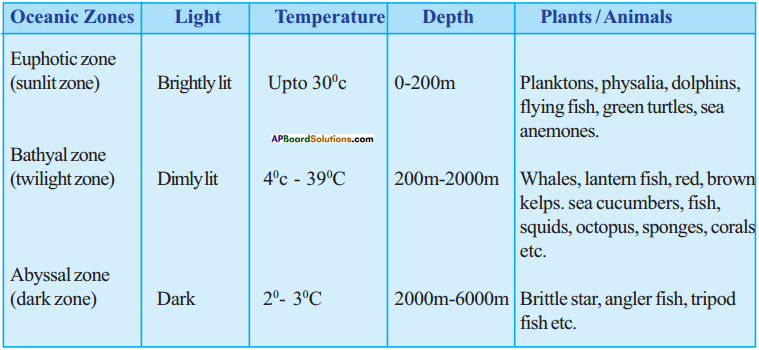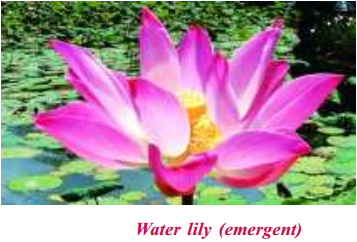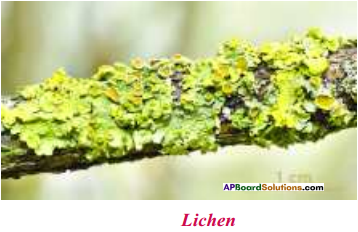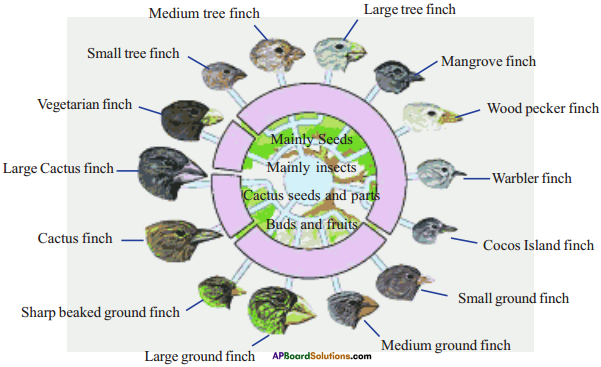AP State Syllabus AP Board 9th Class Biology Important Questions Chapter 9 Adaptations in Different Ecosystems.
AP State Syllabus 9th Class Biology Important Questions 9th Lesson Adaptations in Different Ecosystems
9th Class Biology 9th Lesson Adaptations in Different Ecosystems 1 Mark Important Questions and Answers
Question 1.
Give the names of fresh water reservoirs and lakes in our state.
Answer:
Kolleru Lake of Krishna District is fresh water lake in our state.
Question 2.
What is adaptation?
Answer:
Way and means that organisms adapt or develop over a certain period of time in different conditions for better survival are adaptations of organisms.
![]()
Question 3.
What is transpiration?
Answer:
The loss of water vapour from plants, especially through stomata is called transpiration.
Question 4.
Name the oceanic zone that is most productive.
Answer:
Euphotic zone.
Question 5.
Give some examples of aquatic habitats.
Answer:
Rivers, ponds, lakes, oceans, seas and swamps.
Question 6.
Give some examples of terrestrial habitats.
Answer:
Grasslands, forests, deserts, mountain regions and coastal regions.
![]()
Question 7.
What are nocturnal animals?
Answer:
Animals which are active during night and sle^p during the day are called nocturnal animals.
Question 8.
What are xerophytes?
Answer:
Plants which live in deserts are called xerophytes.
Question 9.
What are the three zones of marine ecosystem?
Answer:
a) Euphotic zone
b) Bathyl zone
c) Abyssal zone
Question 10.
What will affect adaptations to marine life other than the conditions mentioned above?
Answer:
Temperature, pressure, salinity, etc. effect adaptations to marine life.
![]()
Question 11.
What happens to the temperature and pressure as depth increases?
Answer:
When the depth increases, the pressure increases and temperature decreases.
Question 12.
Which zone has more animals?
Answer:
Euphotic zone has more animals. This is because here light is available. So, planktons and plants are available here. Animals can survive here by getting food and other basic needs.
Question 13.
What are the factors which effect the availability of organisms?
Answer:
The factors like light, salt content, food, oxygen effect the organisms and their populations in different ways.
Question 14.
What are the types of aquatic ecosystems? Give examples.
Answer:
Fresh water ecosystem and marine water ecosystem.
Question 15.
What is the use of adaptations?
Answer:
Adaptations provide some improvement for better survival.
![]()
Question 16.
Do all animals living in desert conditions show adaptations?
Answer:
Yes, all animals living in deserts show adaptations.
Question 17.
Which zone do you think when compared to marine ecosystem is absent in fresh water ecosystem?
Answer:
Abyssal zone is absent in fresh water ecosystem.
9th Class Biology 9th Lesson Adaptations in Different Ecosystems 2 Marks Important Questions and Answers
Question 1.
What are the different types of aquatic ecosystem? Give examples.
Answer:
- Aquatic ecosystems are mainly classified into two different types as fresh water and marine ecosystems.
- Ponds, lakes, rivers are the examples of fresh water ecosystem.
- Seas, Oceans are the examples of marine ecosystem.
Question 2.
Write a brief note on nocturnal animals.
Answer:
- Animals which are active during night and sleep during the day are called nocturnals.
- These creatures generally have highly developed senses of hearing and smell.
- They have specially adapted eye sight to see well in dark.
- Animals like bats, emit a high pitched sound which bounses off objects to find prey or protect from predators. E.g.: Cats, rats, bats, owls, insects like crickets, firefly and cattle fish.
![]()
Question 3.
Write a short note on electric eel.
Answer:
- Electric eel is an electric fish.
- It is capable of generating power electric shocks of upto 600 volts, when it uses for hunting self defence.
- It is an apex predator.
- Despite its name, it is not an eel, but rather a knife fish.
Question 4.
The aquatic ecosystem of coringa mangrove region would be less saltier than the bay. Do you agree to this? Why, why not?
Answer:
- Yes, I agree that the aquatic ecosystem of coringa mangrove region would be less saltier than the bay.
- Because aquatic ecosystem of coringa mangrove region receive fresh water from Coringa and Gaderu rivers.
- Distributories of Gautami, Godavari river and number of small rivers and canal transverse this mangrove ecosystem.
- Hence Coringa mangrove region would be less saltier than bay.
Question 5.
What is symbiosis? Give one example.
Answer:
Symbiosis is close and often long term interaction between two or more different biological species. Symbiotic relationships include those associations in which one organism lives on another (ecosymbiosis) and where one partner lives inside the other (endosymbiosis)
![]()
Question 6.
What is hibernation?
Answer:
Hybernation is a state of inactivity and metabolic depression in endotherms. Hibernation refers to a season of heterothermy that is characterized by low body temperature, slow breathing and heart rate and low metabolic rate.
Question 7.
What is bioluminescence?
Answer:
Emission of visible light by living organisms such as the firefly and various fish, fungi, and bacteria.
Question 8.
What is ecosystem?
Answer:
The term ecosystem refers to the combined physical and biological components of an environment.
Question 9.
To know more information about ecosystem, what questions do you ask to you teacher?
Answer:
- What are the biotic and abiotic factors of the ecosystem?
- List out different ecosystems related to man in this biosphere.
- Can we conserve this biosphere by saving ecosystems?
- What is the relationship between man and ecosystem?
9th Class Biology 9th Lesson Adaptations in Different Ecosystems 4 Marks Important Questions and Answers
Question 1.
What are the general aquatic adaptation in animals and plants?
Answer:
- General aquatic adaptations are presence of some special air spaces inside bodies or presence of such substances that help organisms to swim and float in water.
- Organisms bear specialized structures to swim like flippers as in turtles and fins in fishes.
- Fishes, dolphins etc. have floaters in their body to be able to inhabit particular levels in the water body.
- Microscopic photosynthetic organisms like planktons have droplets of oil in their cells that keeps them float.
- Larger plants have tough leaves and flexible stems.
![]()
Question 2.
Write some of the adaptations seen in marine animals.
Answer:
- Specially developed kidneys, gills and body functions help to maintain salt concentrations across membranes through osmosis.
- Simple animals such as anemones or worms absorb the gases through their skin.
- Mobile animals use gills, or even lungs to absorb oxygen from the water and air.
- Many marine mammals have blubber for insulation from the cold and some fish have an antifreeze-like substance in their blood to keep it flowing.
- Marine adaptations also include symbiosis, camouflage, defensive behaviour, re-productive strategies, contact and communication like most other ecosystems on the earth.
- Marine organisms show adaptations to environmental conditions like pressure, temperature, light and salinity.
Question 3.
Write different zones in marine ecosystem, abiotic characteristics and type of organisms present.
Answer:

Question 4.
Write adaptations in some aquatic plants.
Answer:


- Partially submerged plants have numerous air spaces inside the stems, leaves, roots that aid in gaseous exchange and buoyancy.
- Leaf bases of water hyacinth (eichhornia crossipes) form air filled structures to keep them afloat.
- In water lilies leaves are flat, have an oily surface with stomata present on the up¬per surface of the leaf.
- While incompletely submerged plants like hydrilla, stomata are absent, leaves are thin, stems are highly flexible.
Question 5.
What are the adaptations seen in hydrilla plant?
Answer:
- In hydrilla stomata are absent, leaves are thin, stems are highly flexible.
- It can grow at low light intensities.
- It is better at absorbing carbon dioxide from the water.
- It is able to store nutrients for later use.
- It can tolerate a wide range of water quality conditions, for example, salinity.
- Hydrilla can propagate sexually and asexually.
Question 6.
Write a brief note on lichens.
Answer:

- The figure shows the successful adaptation of algae and fungi colonies.
- The more adaptive fb’rms live on to form symbiotic relationship with the fungi in colo-nies called lichens.
- The fungus provides water and minerals to the algae, while the algae performs photo-synthesis and supplies food in the form of sugars to the fungus.
- Due to such symbiotic adaptations lichens are able to survive even in extreme cold conditions.
Question 7.
Write about the research done by Charles Darwin on finches in Galapagos islands.
Answer:

- Charles Darwin in the year 1885 landed from the famous ship H.M.S. Beagle on one of the islands of around 120 small islands of the group of Galapagos islands.
- He studied about different organisms of the islands.
- His most remarkable observation had been about finches (our state bird is also a finch).
- He was amazed to see that 13 types of finches that differed with respect to beaks and the colour of feather.
- He noted that some finches eat seeds, while some eat fruits and the others eat insects.
- Darwin observed that these birds had adapted to their immediate surrounding for food and shelter and showed a lot of variation with respect to the form of beaks.
- Charles Darwin concluded that adaptation was something that an organism is undergoing continuously, even within very close by related forms in a particularly geographically separated area.
Question 8.
What are the adaptations seen in animals living in polar regions?
Answer:
- Animals living in polar regions adapt themselves in different ways.
- They have a thick layer of fat deposited under their skin, or thick fur coat or hair covering their bodies.
- These act as insulators preventing heat loss from their bodies.
- The fat not only insulates the body but helps in producing heat and energy.
- Such adaptations can be seen in whales, seals, bears etc.
![]()
Question 9.
Write about symbiosis and camouflage.
Answer:
Symbiosis:
- When two organisms live together, exchange nutrients and are benefited mutually, the nutrition is called symbiotic nutrition.
- One of the organisms provide nutrients required for the other organism while the other provides shelter or nutrients or both.
- Symbiotic mode of nutrition is seen both plants and animals.
- Nitrogen fixing bacteria living in the root nodules of leguminous plants is a typical example for symbiotic nutrition.
- Plants provide shelter and nutrients to the bacteria while bacteria provide nitrogen compounds to the plant.
- In animals brightly coloured clownfish have adapted symbiotic relationship with anemones to protect both the clownfish and the anemones from predators.
Camouflage :
- A colour or shape in an animals body covering that helps it bend to its environment.
- Usually, animals adapt camouflage to escape from the predator.
- It also help the animal in better survival.
Question 10.
How is the coringa ecosystem different from the marine ecosystem you studied?
Answer:
- Coringa ecosystem is the second largest in the country after sunderbans in West Bengal.
- The coringa mangrove situated at a distance of 20 km from Kakinada is famous for its flora and fauna.
- The mangrove plants have adapted themselves to the environment in which it grows.
- The mangrove ecosystem also has a heavy growth of shrubs and herbs.
- Numerous species of salt-tolerant species constitutes its flora which includes tropi¬cal and subtropical species such as Rhizoporo, Avicinia, Sonnerata Aegiceros and others.
- Whenever conditions favour, the mangroves may form extensive and productive forests in the sheltered coastal lines.
- The mangroves contain a highly specialised community of plants associated with animal species which are not capable of surviving in any other situations.
- Mangroves are salt-tolerant forest ecosystems of tropical and subtropical regions of the world.
![]()
Question 11.
Crocodile, alligator are both the same. Actually, they are not similar. Do you find any differences between them? What are they?
Answer:
Differences between Crocodile and Alligator :
| Crocodiles | Alligators |
| 1) They live in both fresh water and salt water due to functional salt gland on its tongue allowing it to excrete excess salt. | 1) They live in fresh water only. |
| 2) Usually they are grayish green/olive brown in colour. | 2) They are grayish black or nearly black in colour. |
| 3) Usually they can grow upto 19 feet. | 3) They can grow upto 14 feet. |
| 4) Crocodiles weigh nearly 1200 kgs. | 4) Alligator weigh upto 360 to 450 kgs. |
| 5) The upper jaw covers lower jaw hiding the lower teeth. | 5) Both lower and upper teeth are visible when the mouth is closed. |
| 6) ‘V’ shaped snout, very long and narrow in front. | 6) ‘U’ shaped snout (nose) in present. |
9th Class Biology 9th Lesson Adaptations in Different Ecosystems Important Questions and Answers
Question 1.
Read the passage to answer the questions given below.
| The Side-winder adder snake crawls sideways with only a small amount of its body pressed against the hot sand. This technique helps it to keep itself cool. The Golden Mole escapes the heat of the sun by swimming through the sand just below the surface. It rarely emerges out as it finds all the needs below the ground.
Some animals show extraordinary ability to survive in the desert. The Kangaroo Rat of western North American desert can live without drinking water throughout its life. Because its body synthesizes little water in the process of digestion. The desert bird the Sand grouse flies long distances to an oasis in search of water, which it carries back in its feathers for its chicks. |
A) Which desert organism never drinks water?
B) How Golden Mole escapes the heat of sun?
C) From where does Sand grouse get water?
D) Why Side Winder adder snake crawls sideways?
Answer:
A) The Kangaroo rat.
B) The Golden mole escapes the heat of the sun by swimming through the sand just below the surface.
C) Oasis.
D) The Side – Winder snake make crawls sideways with only a small amount of its body pressed against the hot sand. This technique helps it to keep itself cool.
Question 2.
Observe the table and answer the questions given below.
| Name of the animal | Habitation | Adaptation |
| Kangaroo Rat | North America | Doesn’t drink water for lifetime, uses water formed in digestion. |
| Sand grouse | Deserts | Stores water in a special organ called crop present in the abdomen. |
Write adaptation seen in the above animals.
Answer:
- Kangaroo rat can live without drinking water throughout its life. Because its body synthesizes little water in the process of digestion.
- Sand grouse flies long distances to an Oasis in search of water which it carries back in its crop for its nestlings.
![]()
Question 3.
Explain the difficult types of modifications in plants that grow in Deserts?
Answer:
Adaptations in desert plants.
- Leaves are reduced to spines so that there is little transpiration loss and water is stored in the tissues of the stem.
- They have deep root system.
- They store water in stems, (succulent stems)
- Xerophytes have thick cuticle to prevent water loss.
- They have high salt content to increase osmosis.
- Stomata are reduced in number to prevent water loss.
Question 4.
Read the table and answer the following questions.

a) Basing upon what does this ecosystem divided into?
b) What is the range of depth in Euphotic zone?
c) Name the zone that lies between the depths of 200 m – 2000 m.
d) What adaptations do the organisms in abyssal zone contain?
Answer:
a) Basing on the availability of light in different zones of ocean.
b) 0 – 200 mts.
c) Bathyal zone.
d) They are mostly predators and scavengers. They have some special structures to produce light on their bellies and around their eyes, which are non-functional.